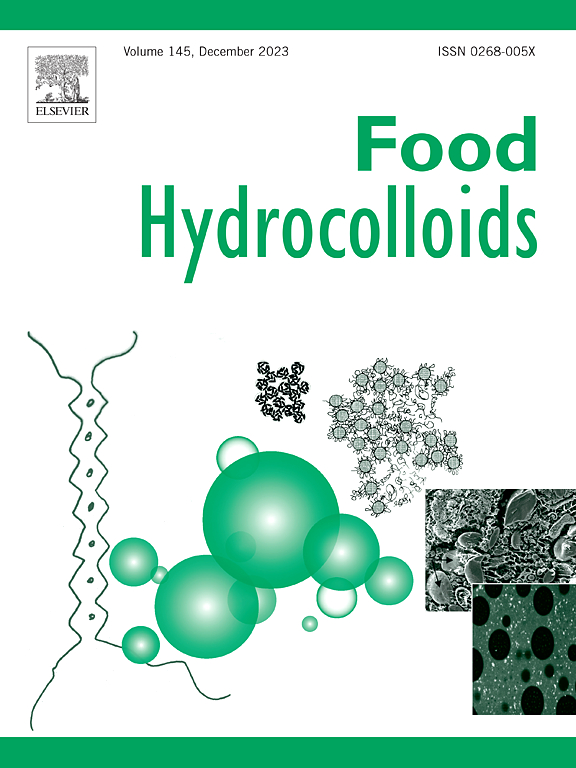Unveiling the binding mechanism between egg white proteins and wheat glutens during the dough mixing process
IF 11
1区 农林科学
Q1 CHEMISTRY, APPLIED
引用次数: 0
Abstract
Hen egg white is mainly composed of ovalbumin (OVA), ovomucoid (OVO), and lysozyme (Lys), all of which impact the gluten network in wheat products. This research explored the effects of these proteins on the gluten network from both structural and molecular interaction perspectives. The addition of OVA, OVO and Lys did not enhance the network structure of gliadin groups (Gli), while Lys promoted a denser and more uniform network structure for glutenin groups (Glu). A higher Lys ratio led to a transition of Glu from β-sheet to α-helix, accompanied by an increase in disulfide bonds, which rose from 52.07 to 82.43 μmol/g, especially in the high molecular weight glutenin subunit (HMW). Such transition then caused a denser sponge-like network along with a higher molecular chain height maximum (8.5 nm) of HMW, likely driven by the stronger molecular affinity between Lys and HMW. The HMW-Lys complex exhibits the higher binding energy and unbinding force than that LMW-Lys group due to the contributions of hydrogen bonds and van der Waals forces, hence providing fundamental support for the gluten development. These findings clarify the contribution of egg white proteins in the dough formation process and may guide future improvements in dough quality.

揭示蛋清蛋白与小麦面筋在面团搅拌过程中的结合机制
蛋清主要由卵清蛋白(OVA)、卵粘样蛋白(OVO)和溶菌酶(Lys)组成,它们影响小麦制品中的面筋网络。本研究从结构和分子相互作用的角度探讨了这些蛋白对面筋网络的影响。OVA、OVO和Lys的加入并没有增强麦胶蛋白基团(Gli)的网络结构,而Lys则促进了谷蛋白基团(Glu)的网络结构更致密、更均匀。较高的赖氨酸比例导致谷氨酸从β-片向α-螺旋转变,并伴随着二硫键的增加,从52.07 μmol/g增加到82.43 μmol/g,特别是在高分子量谷蛋白亚基(HMW)中。这种转变导致了更密集的海绵状网络,HMW的分子链高度最大值(8.5 nm)更高,这可能是由Lys与HMW之间更强的分子亲和力驱动的。由于氢键和范德华力的贡献,HMW-Lys配合物比LMW-Lys基团表现出更高的结合能和解结合力,为面筋发育提供了基础支持。这些发现阐明了蛋清蛋白在面团形成过程中的作用,并可能指导未来面团质量的改进。
本文章由计算机程序翻译,如有差异,请以英文原文为准。
求助全文
约1分钟内获得全文
求助全文
来源期刊

Food Hydrocolloids
工程技术-食品科技
CiteScore
19.90
自引率
14.00%
发文量
871
审稿时长
37 days
期刊介绍:
Food Hydrocolloids publishes original and innovative research focused on the characterization, functional properties, and applications of hydrocolloid materials used in food products. These hydrocolloids, defined as polysaccharides and proteins of commercial importance, are added to control aspects such as texture, stability, rheology, and sensory properties. The research's primary emphasis should be on the hydrocolloids themselves, with thorough descriptions of their source, nature, and physicochemical characteristics. Manuscripts are expected to clearly outline specific aims and objectives, include a fundamental discussion of research findings at the molecular level, and address the significance of the results. Studies on hydrocolloids in complex formulations should concentrate on their overall properties and mechanisms of action, while simple formulation development studies may not be considered for publication.
The main areas of interest are:
-Chemical and physicochemical characterisation
Thermal properties including glass transitions and conformational changes-
Rheological properties including viscosity, viscoelastic properties and gelation behaviour-
The influence on organoleptic properties-
Interfacial properties including stabilisation of dispersions, emulsions and foams-
Film forming properties with application to edible films and active packaging-
Encapsulation and controlled release of active compounds-
The influence on health including their role as dietary fibre-
Manipulation of hydrocolloid structure and functionality through chemical, biochemical and physical processes-
New hydrocolloids and hydrocolloid sources of commercial potential.
The Journal also publishes Review articles that provide an overview of the latest developments in topics of specific interest to researchers in this field of activity.
 求助内容:
求助内容: 应助结果提醒方式:
应助结果提醒方式:


